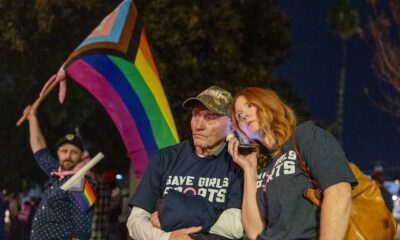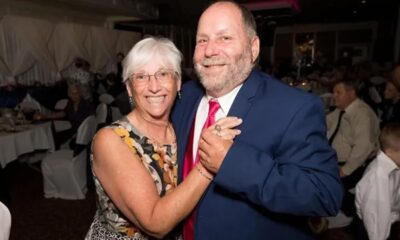San Francisco, CA
Seeing Charli xcx and Troye Sivan at San Francisco's Chase Center? From Bag Policy to Parking, What to Know | KQED

What time does the show at Chase Center start?
Doors are slated to open at 6:30 p.m and the show starts at 7:30 p.m.
As with many concerts, be prepared for a long night. If you don’t mind spoilers, you can view Charli xcx and Troye Sivan’s likely setlist for San Francisco on Spotify.
Concertgoers on the Sweat tour have reported heavy use of strobe lighting, so folks with light sensitivity should be advised. Even if you don’t have any documented issues with strobe lights, you may want to consider taking a style note from Charli herself and packing a pair of large dark sunglasses.
What’s the Chase Center bag policy?
Backpacks (except for single-compartment drawstring bags) and hard-sided bags of any kind are prohibited from entering Chase Center.
Any other bag you bring must be smaller than 14 x 14 x 6 inches in size.
Bags that do not meet the requirements can be checked at one of Chase’s two bag check locations for a fee of $10. Bag check is at the corner of 16th Street and Terry Francois Boulevard.
Here are some more things you cannot bring into the Sweat tour show at Chase Center:
- Bottles and cans
- Refillable water bottles
- Signs over 11 x 17 inches or attached to any pole or stick
- Masks that cover the whole face. (Face coverings to lower your risks of catching — or spreading — COVID-19, like N95 masks, are allowed)
- Lights, tripods and professional recording equipment. Flash photography is not allowed
- Noise-making devices, such as air horns, whistles or cow bells
- Weapons and self-defense items of any kind, including mace, knives and tasers
- Selfie sticks
What else can you bring to Chase Center? These items include:
- Baby bags, plastic bottles and formula
- Diaper bags (with a child)
- Bags accepted as medical bags
- Umbrellas
- Binoculars
While portable phone chargers are not prohibited, Chase Center also offers charging stations compatible with most cellphone devices. Guests may rent a portable charger to take back to their seats for $2 per 30 minutes.
How do I know if I’ve got a good seat at the Sweat tour Chase Center show?
If you are anxious about anything obscuring your sight of the stage or how you want to get to your seat fast, you can check out the view from your seat using Chase Center’s Virtual Venue map.
What should I know about accessibility at Chase Center?
Chase Center addresses questions about accessibility in its online A to Z Guide, which includes information about accessible parking, hearing assistance, ADA-compliant restrooms and service animals.
The venue says guests can request complimentary wheelchair escorts by visiting the kiosks located at Portal 13 and Portal 52 or texting 833-CC4-FANS.
To schedule an American Sign Language interpreter, guests should contact guestexperiences@warriors.com ahead of time.
What should I know about parking at and near Chase Center?
Chase Center has a guide to its parking garage. Tickets for the parking garage are $50.
The venue’s website also refers fans to the third-party parking website SpotHero for other non-Chase Center parking options nearby. It costs $75 to reserve a spot nearest to the stadium, with a 2 minute walk.
There are also cheaper parking options farther away. So, if you’re driving to the show but haven’t secured your parking yet, consider wearing comfier shoes for the walk over and back.
What about using rideshare services like Lyft and Uber at Chase Center?
While getting to the venue using a rideshare service might be fairly smooth, trying to find a car after the show is almost certainly going to be a challenge — and this author is speaking from personal experience. Due to surge pricing, it will also be far more expensive to get an Uber or Lyft as you exit the venue.
There are multiple designated pickup and drop-off zones located within one block of Chase Center. Upon arrival, use one of the designated passenger loading zones (white curbs) along Terry A Francois Boulevard for a safe curbside drop-off. The website also notes, under “Drop-off Locations,” that “if you prefer to walk/take the train to a location where it’s easier to ride-hail, we encourage taking the train/walking along Forth Street towards the Forth and King Caltrain Station.”
As you leave the show, rideshare apps will automatically display the best places to get picked up within a five-minute walk radius.
Accessible drop-offs and pickups are along the curb of 16th Street and Terry Francois Boulevard, with accessible entry and exit from the East Entrance. For folks with mobility considerations, the venue can provide a wheelchair to transport guests from Thrive City Plaza or the main lobby to their seats.
What’s the best way to take public transit to the Sweat tour?
Public transit schedules can always be subject to change. Check the timings for your route on the day of the show itself, and be sure of your very last service home. Chase Center has a comprehensive guide to public transportation on its website.
SF Muni
Any Chase Center patron who shows their event ticket at Muni turnstiles and boarding platforms can ride Muni without charge.
There is a Muni Metro rail stop serving the venue on the T Third Street line, which connects Chinatown and Sunnydale. See the Muni Metro schedule.
BART
Several BART stations have convenient connections to get to the venue.
Muni Route 22 connects to the 16th Street and Mission BART station. This stop is located on Third Street and Gene Friend Way.
Muni Route 15 serves as a connection to Montgomery Street BART station. This stop is located on Third Street and Warriors Way.
You can transfer to the new Union Square Muni Metro rail station from Powell BART station via the underground corridor to take the T Third Street line or S Shuttle Mission Bay line to the UCSF/Chase Center stop.
You can find more information and schedules on the BART website.
Caltrain
If you take Caltrain to San Francisco, you can walk 15–20 minutes along Fourth Street and turn left on Gene Friend Way to Chase Center.
You can also transfer from the Caltrain station to the Muni Metro T Third Street platform, which is located across the street, and take Muni to the UCSF/Chase Center stop.
Since the show is on a Sunday, the last train leaving San Francisco is around 12 a.m., but be sure to check the Caltrain’s weekend schedule.
Biking
Chase Center offers guests free bike valet for the first 300 bikes an hour before start time. The valet is available along 16th Street. Public bike parking is available along 16th Street and Terry Francois Boulevard.
There is also a Lyft/Bay Wheels bike share station at the intersection of Warriors Way and Terry Francois Boulevard. While they’re convenient and easy to use, the limited availability of these bikes means you should have a backup plan — or you might get stranded.
Can I still get a ticket to the Sweat tour?
According to Ticketmaster, tickets are still available, with the lowest at $279
You may find better deals with resale tickets on sites like StubHub, but you should make sure you are not purchasing fake tickets. Read more tips about avoiding ticket resale scams.

San Francisco, CA
1 critically injured in shooting near San Francisco homeless shelter

1 hospitalized in SF shooting, suspect arrested
San Francisco police are investigating a shooting near a homeless shelter that left a person with life-threatening injuries Saturday evening.
SAN FRANCISCO – San Francisco police are investigating a shooting near a homeless shelter that left a person with life-threatening injuries Saturday evening.
Police said the shooting occurred in the 500 block of Fifth Street. They responded to the area around 6:30 p.m. There, they found the victim with gunshot wounds.
They took the victim to a local hospital with life-threatening injuries.
While at the scene, 29-year-old Taylor Reed approached officers, police said. Officials said the officers had probable cause to arrest Reed for the incident.
Charges are still pending, according to the San Francisco Police Department. Reed remains in the San Francisco County Jail.
San Francisco, CA
Marin advocate for disabled gets San Francisco post

Eli Gelardin, the longtime head of the Marin Center for Independent Living, has accepted an offer to lead the Mayor’s Office on Disability in San Francisco.
Gelardin, a longtime Marin disability rights advocate who led the center for 17 years, is set to start the new job on Jan. 6.
“It’s been an honor to work with a community that celebrates disabled joy and values lived experience,” Gelardin said. “Our collective efforts have always been about more than services — they’re about building a world where disabled lives are truly valued.”
Susan Malardino, the organization’s deputy director, will run it during the search for Gelardin’s replacement. The San Rafael organization offers social services and other resources to people with disabilities in Marin.
San Francisco Mayor London Breed and City Administrator Carmen Chu announced Gelardin’s appointment on Dec. 18.
“We must continue to advocate for and protect our most vulnerable populations, and under Eli’s leadership the office will continue to work to ensure people with disabilities of all ages can live healthy, empowered lives in San Francisco,” Breed said.
Gelardin will oversee Americans with Disabilities Act implementation in city departments and programs. The position also provides guidance to the mayor’s office, the Board of Supervisors and other city departments on issues related to disabled people.
The Office on Disability staffs the Disability Council, which provides a public forum for policy.
“I look forward to working with him on our city’s efforts to make every service, program and space accessible to people with disabilities,” Chu said.
Gelardin has achondropolasia, a form of dwarfism. He was born in Boston and moved to Ross with his family when he was 7.
Gelardin graduated from Redwood High School in 1997 and received a bachelor’s degree in psychology from the University of California at Berkeley in 2002.
He joined the Marin Center for Independent Living in 2003 and became executive director in 2008.
In August, Gov. Gavin Newsom appointed Gelardin to serve on the California State Rehabilitation Council. It advises the California Department of Rehabilitation on employment and independent living programs for people with disabilities.
Gelardin’s work as head of the Marin Center for Independent Living has been lauded.
Lee Uniacke, a member of the board, said, “Eli’s made sure that our community has a seat at the table in every state and regional coalition of consequence. He’s a natural leader who people enjoy working with.”
The center was founded by a group of volunteers in 1979 and established as a nonprofit organization in 1980. It is the leading disability rights organization in Marin and has an annual budget of about $2.1 million.
San Francisco, CA
The Golden Gate Bridge Was a Dream That Turned Into a Depression-Era Nightmare for the 11 Men Who Died During Its Construction
/https%3A%2F%2Ftf-cmsv2-smithsonianmag-media.s3.amazonaws.com%2Ffiler_public%2Fbe%2F7b%2Fbe7bfa39-ecb3-42ab-92cc-5ebcde41a5ec%2Fgettyimages-530797710.jpg)
The construction of the Golden Gate Bridge was an immense project with an immense cost.
George Rinhart / Corbis via Getty Images
Today, San Francisco’s Golden Gate Bridge may be the world’s most photographed. Upon its completion, it became Earth’s longest suspension bridge and the Bay Area’s most famous attraction.
But in the early 20th century, it was just an impossible dream—and when construction workers broke ground on January 5, 1933, work started inauspiciously as they began moving three million cubic feet of dirt.
The idea for a bridge across the Golden Gate Strait, where the Pacific Ocean flows into the bay in Northern California, was first floated in 1872 by railroad mogul Charles Crocker. But most dismissed Crocker’s idea. A bridge stretching almost two miles across open ocean? Unfeasible.
Nearly five decades later, in 1916, San Francisco engineer James H. Wilkins re-proposed the bridge, and by 1919, officials tasked city engineer Michael M. O’Shaughnessy with exploring the idea. When O’Shaughnessy consulted with engineers from across the country, most estimated such a project would cost more than $100 million, if it could be done at all.
One engineer, though, believed in the project from the start: Joseph B. Strauss, who told O’Shaughnessy it could be built for around $27 million.
Strauss’ original design was a dud, so he recruited other players who steered the project onto a successful course. Charles Ellis, an Illinois engineer, and Leon Moisseiff, designer of New York City’s Manhattan Bridge, drew up a new, $35 million plan. Architect Irving Morrow contributed the Gate’s famous aesthetics, like its Art Deco lines, dramatic lighting and iconic reddish color—called “industry orange.”
Construction began in January 1933. In 1934, the north tower was raised, and in 1935, the south pier. By 1936, workers had built a precarious catwalk between them so they could build suspension cables in situ.
Facing Pacific winds atop the towers, workers insulated their jackets with crumpled newspaper. “You put all the clothes on you had and worked, worked hard, or you’d freeze,” worker Martin Adams told KQED. He called the Golden Gate Strait “the coldest place I’ve ever worked.”
Still, it was the 1930s—the middle of the Great Depression—and people were desperate for work. Hopeful men lined up, waiting for construction jobs that would open when laborers inevitably died on the job.
Loss of life was expected with big projects like this one, but Strauss took a special interest in protecting the bridge’s builders. Workers wore special hard hats and glare-free goggles, and Strauss insisted on an unheard-of construction feature: a $130,000 safety net. It ended up catching 19 men, who called themselves the “Halfway to Hell Club.” But it didn’t catch all who fell.
On February 17, 1936, construction workers were tasked with removing wooden scaffolding, working from a temporary catwalk. Adams watched as the catwalk broke away, ripped through the safety net and fell into the ocean, taking 12 men with it—220 feet down.
“The only thing that went through my mind was survival,” said Slim Lambert, one of the falling men. “I knew that to have a prayer, I had to hit the water feet first.”
When Lambert plunged into the Pacific, his legs became tangled in the sinking net. He was pulled so deep that his ears bled before he untangled himself and swam to the surface. He and two others were plucked from the waves by a crab fisherman, but only Lambert and colleague Oscar Osberg survived.
Construction continued. By May 1936, the cable compression was finished, In November, two main span sections were joined, marked by a blessing with holy water. In the first half of 1937, the roadway was paved.
Finally, on the morning of May 27, 1937, 18,000 people gathered on each side of the finished Golden Gate Bridge as it opened to pedestrians. San Franciscans had fun with it, marking historic firsts: The San Francisco Chronicle recorded the first person to walk across the bridge on stilts, pushing a stroller, on roller skates, on a unicycle and while playing a tuba. A week’s worth of celebrations became known as the Golden Gate Bridge Fiesta.
The bridge has since become a symbol of architectural ingenuity and Bay Area style. After all, its construction was championed by citizens who voted to spend a fortune building a structure once deemed impossible in a time of economic strife.
-

 Health1 week ago
Health1 week agoNew Year life lessons from country star: 'Never forget where you came from'
-
/cdn.vox-cdn.com/uploads/chorus_asset/file/24982514/Quest_3_dock.jpg)
/cdn.vox-cdn.com/uploads/chorus_asset/file/24982514/Quest_3_dock.jpg) Technology1 week ago
Technology1 week agoMeta’s ‘software update issue’ has been breaking Quest headsets for weeks
-

 Business5 days ago
Business5 days agoThese are the top 7 issues facing the struggling restaurant industry in 2025
-

 Culture5 days ago
Culture5 days agoThe 25 worst losses in college football history, including Baylor’s 2024 entry at Colorado
-

 Sports5 days ago
Sports5 days agoThe top out-of-contract players available as free transfers: Kimmich, De Bruyne, Van Dijk…
-

 Politics3 days ago
Politics3 days agoNew Orleans attacker had 'remote detonator' for explosives in French Quarter, Biden says
-

 Politics3 days ago
Politics3 days agoCarter's judicial picks reshaped the federal bench across the country
-

 Politics1 day ago
Politics1 day agoWho Are the Recipients of the Presidential Medal of Freedom?















